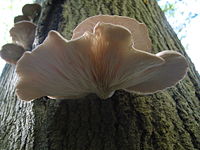
Photo from wikipedia
The present study aimed to remove tetracycline (TET) antibiotic molecule from an aqueous medium using adsorbents prepared from Rhizopus oryzae biomass. The TET adsorption process was discontinuous and the adsorbent… Click to show full abstract
The present study aimed to remove tetracycline (TET) antibiotic molecule from an aqueous medium using adsorbents prepared from Rhizopus oryzae biomass. The TET adsorption process was discontinuous and the adsorbent biomass was crude and NaOH-sonication–modified Rhizopus oryzae fungi. Specific active surface area for crude and modified Rhizopus oryzae was 10.38 m2/g and 20.32 m2/g, respectively. The results showed that the maximum TET adsorption efficiency was determined at pH 4, temperature 25 °C, initial TET concentration 10 mg/L, contact time 80 min, and biomass quantity 2 g/L. The equilibrium behavior showed that the Langmuir model suitably described the process. The maximum TET adsorption capacity was determined to be 38.02 mg/g and 67.93 mg/g, respectively, indicating that the method of biomass modification promoted the bio-adsorption capacity. A higher correlation coefficient (R2) and lower RMSE for the pseudo-first-order kinetic than other models showed its ability to describe the behavior of TET bio-adsorption. The enthalpy thermodynamic parameter (ΔH°) for the TET adsorption process was determined − 63.847 kJ/mol and − 85.226 kJ/mol for the raw and modified Rhizopus oryzae, respectively. Therefore, it can be suggested that the biomass of Rhizopus oryzae especially the modified version can be effectively used for the TET removal from aqueous environments.
Journal Title: Environmental Science and Pollution Research
Year Published: 2020
Link to full text (if available)
Share on Social Media: Sign Up to like & get
recommendations!